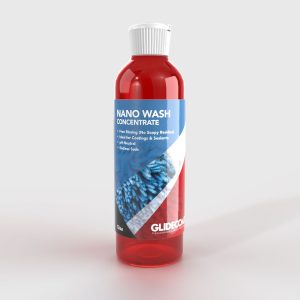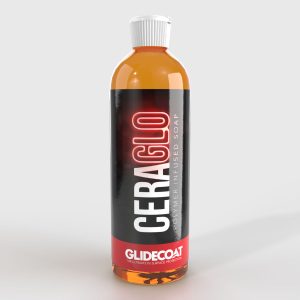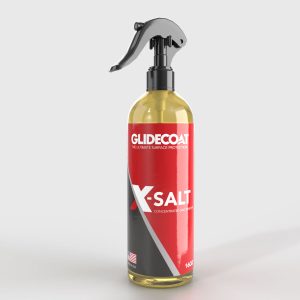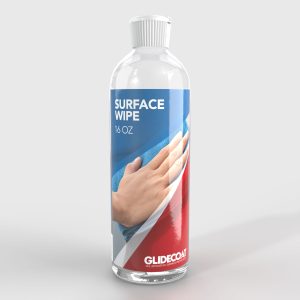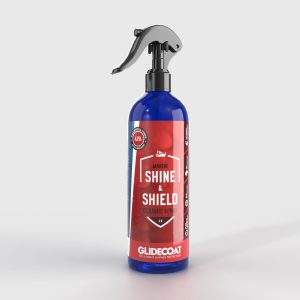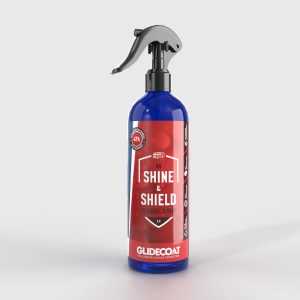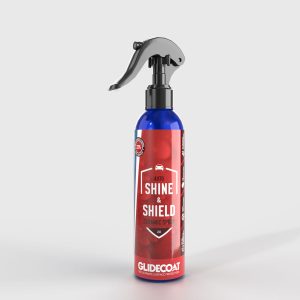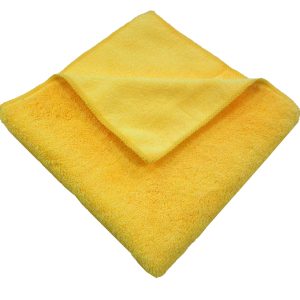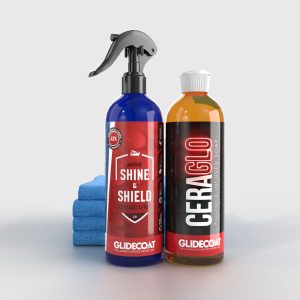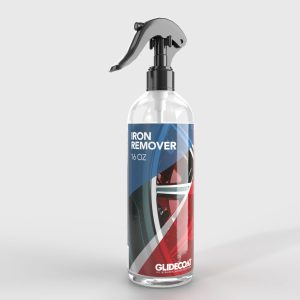Glidecoat Ceramic Coatings Maintenance Guide
APPLICATION SPECIALIST
Ceramic coatings have become increasingly popular in the detailing world over the past few years, but even with the popularity of ceramic coatings there is still a lot of misinformation about coatings and what they can do.
Ceramic coatings are one of, if not the best product to protect and preserve the integrity of your surface, far superior to traditional wax and sealants (especially in the marine and RV market). One of the most common misinterpretations of a ceramic coating is that they are almost maintenance free, or your boat/vehicle/RV will not get dirty if it has a ceramic coating. That is simply not the case.
While ceramic coatings are extremely durable, they require ongoing maintenance to ensure that you are getting the full benefits and protection out of your ceramic coating. With that being said, the main benefit of having a ceramic coating is that your ongoing maintenance is much easier and more effective (with less effort) than using a traditional wax or sealant.
In this ceramic coating care and maintenance guide we will explain how to properly maintain a ceramic coating to ensure you are getting the most out of your ceramic coating, and properly protect your investment.
After the application of any of our ceramic coatings, it is important to let the coating fully cure before getting the vehicle wet, washing the vehicle or putting your boat back in the water. A full cure of our Marine and RV ceramic coatings is between 12–15 hours, whereas the Auto 9H and Trim Ceramic Coatings fully cure in 48 hours. Cold temperatures cause the coating to cure slower, so plan for maximum cure time if applied in cooler weather.
If rain is imminent during the application, make sure you stop applying the coating at least 1-2 hours before it rains to allow the coating to begin the curing process. If the vehicle/boat gets wet or rained on during the curing process, dry as soon as possible, and avoid leaving the vehicle/boat to air dry to prevent potential water spots on the surface.
Note: Allow a minimum of 48 hours before washing to ensure the coating has fully cured.
After the coating has fully cured, we recommend bi-weekly washes, and spot cleaning as needed. For marine coatings, we also recommend the ongoing maintenance of rinsing (and drying) after every use. For RVs, we recommend rinsing (and drying) after every long trip.
Ongoing maintenance is an important factor in ensuring that you get the most benefits from your ceramic coating. If a coating is too dirty, this layer of contamination (salt, bugs, dirt, bird droppings, water spots) will diminish the stain resistance and hydrophobic properties of the ceramic coating, making the surface more difficult to clean, defeating the main purpose of a ceramic coating.
Here are some general guidelines for ongoing maintenance of your ceramic coating:
- Marine: Rinse your boat after every use to remove contaminants from the surface. We highly recommend drying your boat after rinsing, and avoid letting you boat air dry, which may cause water spots.
- RV: Bugs are one of the biggest issues for RV owners. After a long trip on the road, the front cap will typically be covered in bug guts. These bug guts can be highly acidic and cause etching on the gel coat or paint if they are left on the surface too long. We highly recommend spot cleaning the RV after long trips to easily remove the bugs from the surface before they can cause any ill effects to the coating. RV Shine and Shield or Glidecoat’s Surface Wipe are great for spot cleaning.
- Bi-weekly washes (every two weeks) with Glidecoat Nano Wash or Glidecoat Ceraglo. Avoid using high pH soaps such as Dawn dish soap, or soaps that contain heavy cleaners of degreasers. These soaps won’t harm the coating after a few uses, but continual use of aggressive soaps and cleaners will expediate the wear of the top layer of coating. This will diminish and reduce the protective qualities of the ceramic coating, as well as reduce the longevity of the coating. Glidecoat Ceraglo is the perfect after care soap for you ceramic coating. Ceraglo is a polymer infused soap designed to increase the gloss of the surface while leaving a layer of protection on top of the ceramic coating to promote the longevity.
- Avoid using stiff bristled brushes or abrasive washing tools.
- Use a microfiber wash mitt or a soft bristled brush when washing.
- Dry the vehicle/boat with a microfiber drying cloth or a clean chamois.
- Don’t let the surface air dry, this will cause water spots on the ceramic coating. Over time these water spots can etch into the coating and become difficult to remove. If there are areas that you cannot access to dry, we recommend using a stream of water (not a spray nozzle) down the sides to remove contaminants while not leaving excess water on the surface that could cause water spots.
- Auto: Avoid drive through car washes. Automatic car washes use abrasive brushes that can scratch the surface and damage the protective layer of the coating.
-
Nano Wash
$16.45 - $89.95The product produces a high foam content, which breaks the bond between the dirt film and your boat’s gelcoat or paintwork and lubricates dirt particles minimizing surface abrasion.
Select options This product has multiple variants. The options may be chosen on the product page
-
Ceraglo Polymer Infused Soap
$19.95 - $119.95Ceraglo is the perfect after-care soap for any ceramic coating. Ceraglo is a pH neutral premium soap that produces a high foam content and the added polymer provides an additional layer of protection to help extend the life of your ceramic coating.
Select options This product has multiple variants. The options may be chosen on the product page
In between your bi-weekly washes you may need to do some spot cleaning. Whether it’s salt build up on the hull, water spots from the rain, bird droppings or bugs, we recommend cleaning them as you see them to make your ongoing maintenance that much easier.
Here are some general guidelines for spot cleaning:
- Marine: For excess salt buildup on your hull we recommend using Glidecoat X-Salt to safely remove the salt without harming the ceramic coating. Simply spray X-Salt on the surface, allow it to dwell for 5-10 minutes, then rinse it off. X-Salt can also be added to your wash bucket with Glidecoat Nano Wash or Glidecoat Ceraglo to help remove stubborn salt buildup while you wash.
- Marine:If you are in an area without salt water and/or are having issues with hard water spots we recommend using Glidecoat WaterSpot Remover to safely remove hard water spots without harming the ceramic coating. Simply spray Glidecoat WaterSpot Remover onto the surface, wipe it in with a microfiber cloth, allow it to dwell for 2-3 minutes then wipe it off with a clean microfiber cloth.
- If you are noticing a loss in hydrophobic quality, it may be caused by a build-up of iron particles (rail dust, brake dust, air pollution, industrial fallout, etc.), which can affect the way the water reacts to the surface. In this scenario we would recommend using Glidecoat Iron Remover to remove these contaminants from the surface. When using Iron Remover, first wash the surface to remove surface dirt, then spray surface to be cleaned with Glidecoat Iron Remover and let dwell for 5-10 minutes. Do not let the Iron Remover dry. A light mist of water may be used to keep the surface wet. Agitate the surface with a soft wash mitt, towel or sponge dedicated for use with Glidecoat Iron Remover. Finally, rinse decontaminated surface thoroughly with water to ensure all Iron Remover is rinsed away.
- When spot cleaning bird droppings or small stains, use Glidecoat Surface Wipe or a waterless wash to remove contamination from the surface. Always use a microfiber cloth when spot cleaning and avoid using excessive pressure when removing stains.
-
X-Salt Concentrated Salt Remover
$21.95 - $99.95X-Salt is Glidecoat’s answer to salt build-up on the surface of your boat, car or RV. Glidecoat X-Salt is safe to use on all metals, gel coat, painted surfaces, fiberglass, rubber, chrome, glass, plastic and most any surface exposed to salt.
Select options This product has multiple variants. The options may be chosen on the product page
-
Surface Wipe
$27.45 - $174.95Surface Wipe is a one-step preparation product that removes oils and contaminants before applying Gildecoat ceramic coating or polishing applications.
Select options This product has multiple variants. The options may be chosen on the product page
In addition to ongoing maintenance and spot cleaning, ceramic coatings benefit from a maintenance spray every 3-4 months, such as Glidecoat Shine and Shield. For Marine use, we recommend applying every 3-4 months in Southern States, whereas Northern States should apply one a season. Simply choose the product to meet your need – Marine, Auto, or RV. Shine & Shield will enhance the shine and hydrophobic effect of the surface, while adding an additional layer of protection on top of the ceramic coating to promote longevity.
Shine and Shield is a simple spray on, wipe off application.
Here are some general guidelines for applying Shine and Shield for quarterly maintenance:
- Shine and Shield can be applied as needed to add gloss and water beading to the surface.
- Do not apply Shine and Shield to a dirty surface, always clean/wash the area first before applying.
- Shine and Shield can be applied to a wet surface, allowing you to dry the surface while leaving some protection behind.
- We recommend using two microfibers when applying Shine and Shield, using the first microfiber to buff the surface while using a second clean microfiber to ensure the surface is smooth and uniform.
- Shine and Shield can be layered with multiple coats for enhanced protection, allow a minimum of 30 minutes between each coat.
-
Marine Shine & Shield 2.0 Ceramic Spray
$32.95 - $219.95Marine Shine & Shield 2.0 pushes the boundaries of a ceramic spray with 42% active ingredient, giving you ceramic protection for up to 6 months with a simple application.
Select options This product has multiple variants. The options may be chosen on the product page
-
RV Shine & Shield 2.0 Ceramic Spray
$32.95 - $219.95RV Shine & Shield 2.0 is a must-have for RV owners. Simply spray on and then lightly buff with a microfiber cloth and your RV will shine like new, resist stains and bugs, stay clean longer, and be protected from UV damage.
Select options This product has multiple variants. The options may be chosen on the product page
-
Auto Shine & Shield 2.0 Ceramic Spray
$19.95 - $199.95The new formulation of Auto Shine & Shield provides a protective layer that is extremely hydrophobic making the surface of your car easy to maintain for up to 6 months.
Select options This product has multiple variants. The options may be chosen on the product page
-
Premium Microfiber Towels (12 and 24 packs)
$29.95 - $49.95A heavy cloth with standard pile on one side and double length pile on the reverse side. The extra pile makes for an incredibly soft and absorbent towel which is an excellent match for detailing.
Select options This product has multiple variants. The options may be chosen on the product page
We recommend having your ceramic coating inspected at least once a year by the initial installer to ensure everything is working properly.
An annual coating inspection typically consists of a decontamination wash with Glidecoat Iron Remover to remove contamination from the surface that could be impacting the hydrophobic properties of the ceramic coating. After applying the Iron Remover, wash with Glidecoat Nano Wash or Glidecoat Ceraglo. Then, closely inspect the coated surfaces to ensure that the ceramic coating is holding up as expected.
If any of the high sun exposed areas have significantly diminished in gloss (determined by the gloss meter) it may require a light polish to restore the shine to that area and an additional coat of the ceramic coating to be applied. Otherwise, apply Shine and Shield to all coated areas.
-
Iron Remover
$27.45 - $109.95Glidecoat Iron Remover dissolves and safely removes the ferrous metal iron contamination from rail dust, brake dust, air pollution and industrial fallout. Iron decontamination spray is safe to use on all exterior painted surfaces, wheels, plastic and
Select options This product has multiple variants. The options may be chosen on the product page

